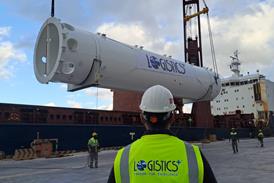July 17 - France based crane operator Hugon deployed its Liebherr LTC 1045-3.1 compact crane on a tricky job inside the mediaeval town of Carcassonne, in the south of the country.
The 45-tonne mobile crane had to negotiate narrow streets, gates, tight bends and cobblestones around the 800-year old village.
Before driving into Carcassonne the crane was adjusted into its most compact configuration. The cab was moved into working position and the storage box was removed, reducing the overall length of the crane by 1.2 m.
The flashing light on the ballast block was unscrewed and removed, the telescopic boom lowered and external mirrors moved inwards.
The compact crane was guided through the streets by driver Fabrice Bresson along with two marshals, including Christophe Vergès, a member of the technical staff at Hugon.
The most challenging obstacle for the team was a tight S-bend at the start of the course - a passage through the outer ring of the fort was around 25 m long and consisted of four gates, the last of which was offset at an angle of 45 degrees.
The crane was set to crab steering speed; all-wheel steering and independent rear axle steering was enabled to maximise manoeuvrability and minimise the crane's turning circle. Despite a very tight squeeze, the LTC 1045-3.1 passed through the gates without touching the centuries-old stones.
"Carcassonne is actually a UNESCO World Heritage site. Making a mistake like touching the walls was simply unthinkable," said Vergès.
Approximately 30 minutes after entering the Carcassonne, the crane had reached its final destination 400 m inside the city walls. At the jobsite the LTC 1045-3.1 was tasked with lifting two distributer boxes - each weighing one tonne - onto a rooftop and removing older units.
The LTC 1045-3.1's return journey through the city proved to be more troublesome due to a number of tourists on the narrow streets. The two marshals now had to help the crane driver, as well as redirect tourists that walked in front of the crane taking photos.


















